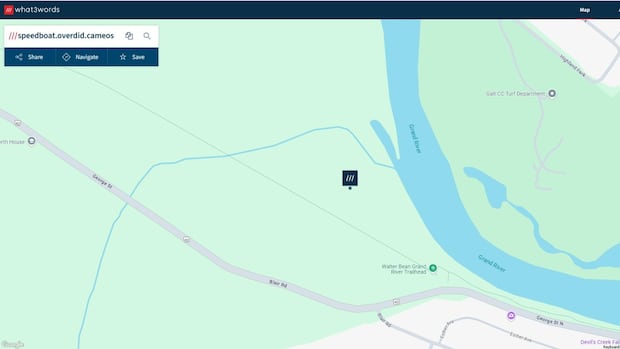[
Speedboat. Overdid. Cameos.
Those three words helped Waterloo Regional Police Service (WRPS) find a woman who was lost at night on the Walter Bean Trail in Cambridge, Ont., earlier this month.
The woman was using the app what3words, which uses a technology that can pinpoint someone’s location within three square metres.
She called 911 first, but was unable to give her location. She downloaded the What3words Ltd. app, through which police sent her a link. When she clicked it, officers could pinpoint her location with those three words.
WRPS 911 dispatcher Jon Chessum said the app has been used by communicators and officers for five years because of its effectiveness.
While Chessum couldn’t give too many details on the case of the lost Cambridge woman, he said the app and technology around what3words result in “one of the simplest ways to talk about location.”
Now, Chessum and police are reminding Waterloo region residents that using the app “helps in emergency situations and it does get people help faster.”
Lost in the dark, but not for long.
A woman who became lost at night on the Walter Bean Trail in Cambridge was safely located after a WRPS communicator sent her a link from the @what3words app. When she clicked it, officers were able to pinpoint her location to this 3m square… pic.twitter.com/O2wQkzj2fO
‘A grid over the whole world’
Jane Stephenson, marketing director of what3words, described the app as a “grid over the whole world, divided into three-by-three-metre squares.”
“Every single square has an address of three random words. So I’m speaking to you today from our office, where the entrance [words are] filled, count, soap,” she said.
What3words is a U.K.-based navigation technology company created 10 years ago by Chris Sheldrick, who got the idea after constantly getting lost or not being able to find friends while attending music festivals.
According to the company’s website, it was initially created to ease “festival-goers and travellers to delivery drivers, event organizers and postal services,” but has been used more and more by emergency services.
To come up with the technology, Sheldrick enlisted mathematician Mohan Ganesalingam and translation expert Jack Waley-Cohen to create a three-word address algorithm.
The app is free to use, only charging businesses to integrate the technology into their own product or systems.
“It’s fascinating, the stories we hear every day about the different cases,” Stephenson said.
She noted she’s seen the app used in the U.K. when an 18-foot python got loose in the countryside. She believes that versatility is what makes it so popular, including for running groups, for hiking, for kind of making sure that critical suppliers get to the right part of a warehouse.”
Peter Johnson is an associate professor of geography and environmental management at the University of Waterloo in southern Ontario.
Johnson said use of the app by the police is an “interesting use case … and something that they are moving their business model towards.”
“I’m also wondering why the 911 operator couldn’t have just pinged their phone and then relayed the [latitude and longitude] to police?” he also said in an email to CBC News.
Johnson did, however, acknowledge that traditional co-ordinates and addresses may not be of much use in more rural areas with no municipal address. Chessum, with WRPS, said that is often the case.
Chessum said the only time they see issues with the app are if someone in an emergency situation continues to move from the location after calling for help.
What3words is used in 193 different countries and translated in 60 languages. Stephenson attributes the growing use of the app to its approachability and accessibility.
Chessum said WRPS strongly recommends using and getting to know the app if going hiking, to a festival or for any other emergency where a loved one might need to know your location.
